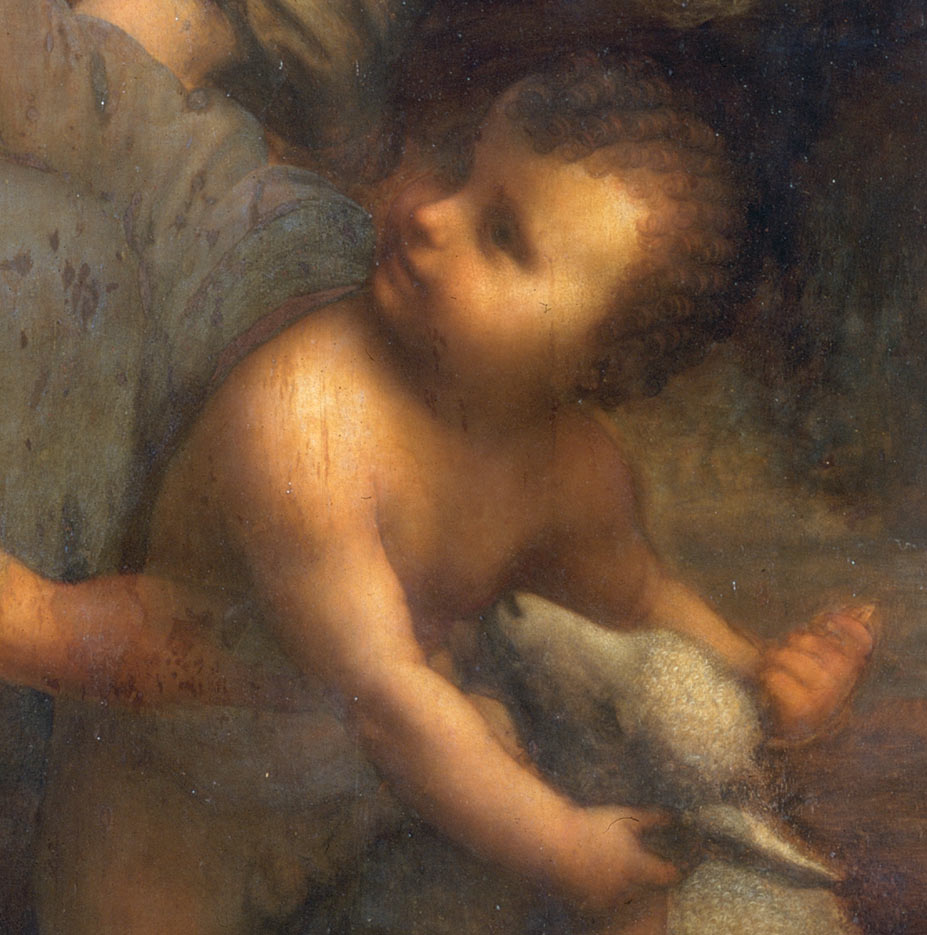
 Leonardo da Vinci, The Virgin and Child with Saint Anne, 1510, Oil on wood, 168 x 130 cm (5 1/2 x 4 1/2 ft.) Musée du Louvre, Paris |
|
|
THE CHILD IN ART
FILM MUSIC
In art history, before the end of the eighteenth century, the child as an independent subject matter hardly existed. The child usually appeared symbolically or allegorically as cupid, putti, or an angel. The child also appeared as a miniature adult as in the depiction of young gods, kings, or, in Christianity, Jesus. This, however was to change with the advent of the Romantic movement in Europe. Around 1800, artists, such as William Blake, Louis Leopold Boilly, and Phillip Otto Runge, began to have children appear as individuals in their works, disconnected from their previous symbolic baggage. The image of this now liberated child was one that promised innocence, freedom, and curiosity. However, now made mortal, there was also the necessary introduction of emotions, sexuality, and the prospect of pain, suffering, and death. There are a number of these earlier artists who were especially meaningful to Helnwein in their portrayal of children. Among them were Lewis Carroll (Charles Dodgson) with his adoration of feminine adolescence; Edvard Munch and his depiction of suffering and sexual awakening; and Balthus with his preoccupation with secrets and the erotic. The children in these works have a knowing look in their eyes. There was a sense of life experienced, both good and bad, which made these works so intense and, in their own day, so controversial. It was apparent from the reception that these artists and others received, however, that any derivation from the most bland representation of children as innocents was cause for violent backlash from society. The public was then, as it is now, very uncomfortable about showing the child as having a sexual identity, however subtle, or suffering in any way, whether physically or emotionally. Artists like Munch were willing to risk the wrath of propriety in seeking out this unexplored area of human experience. For Gottfried Helnwein, it became the major theme of his career.
Robert Flynn Johnson
Tutankhamun 1332 - 1323 B.C. Jan van Eyck 1390 - 1441 Dierick Bouts 1410/20 - 1475 Petrus Christus 1410/20 - 1473 Giovanni Bellini 1430 - 1516 Andrea Mantegna 1431 - 1506 Hans Memling 1433 - 1494 Domenico Ghirlandaio 1449 - 1494 Leonardo Da Vinci 1452 -1519 Gerard David 1460 - 1523 Giovanni Francesco Caroto 1470 - 1546 Lucas Cranach der Ältere 1472 - 1553 Raphael Sanzio 1483 - 1520 Titian 1485 - 1576 Lorenzo Lotto 1480 - 1557 Hans Holbein der Jüngere 1497 - 1543 Bronzino 1503 - 1572 Pieter Bruegel der Ältere 1525 - 1569 Peter Paul Rubens 1577 - 1640 Georges de la Tour 1593 - 1652 Diego Velazquez 1599 - 1660 Rembrandt van Rijn 1606 - 1669 Jean Baptiste Greuze 1725 - 1805 John Singleton Copley 1738 - 1815 Francisco de Goya 1746 - 1828 Philipp Otto Runge 1777 - 1810 Ludwig Schnorr Von Carolsfeld 1788 - 1853 Ferdinand Georg Waldmüller 1793 - 1865 Peter Fendi 1796 - 1842 Eugène Ferdinand Victor Delacroix 1798 - 1863 Friedrich von Amerling 1803 - 1887 Theodor Hildebrandt 1804 - 1874 Josef Danhauser 1805 - 1845 Franz Eybl 1805 - 1880 Heinrich Hoffmann 1809 - 1894 Johann Baptist Reiter 1813 - 1890 John Everett Millais 1829 - 1896 Lewis Carroll 1832 - 1898 Wilhelm Busch 1832 - 1908 Edgar Degas 1834 - 1917 Franz Defregger 1835 - 1921 Pierre-Auguste Renoir 1841 - 1919 Vincent Willem van Gogh 1853 - 1890 John Singer Sargent 1856 - 1925 James Ensor 1860 - 1949 Edvard Munch 1863 - 1944 Winsor McCay 1867 - 1934 Lyonel Charles Adrian Feininger 1871 - 1956 Pablo Picasso 1881 - 1973 Chaim Soutine 1893 - 1943 Norman Rockwell 1894 - 1978 Balthus 1908 - 2001 Lucian Freud 1922 - Present Antonio López García 1936 - Present Günter Brus 1938 - Present Joel-Peter Witkin 1939 - Present Chuck Close 1940 - Present Robert Crumb 1943 - Present Christian Boltanski 1944 - Present Gottfried Helnwein 1948 - Present Marlene Dumas 1953 - Present Cindy Sherman 1954 - Present Trevor Brown Unknown - Present Yoshitomo Nara 1959 - Present
|
||